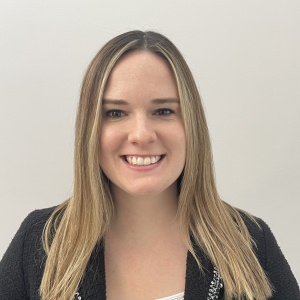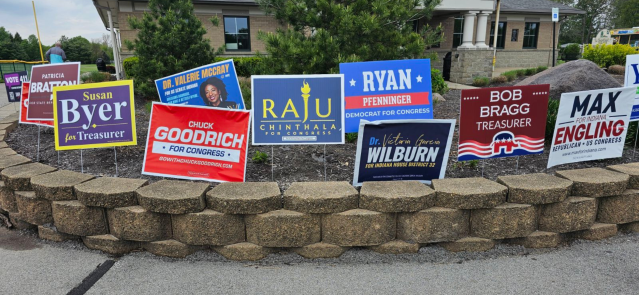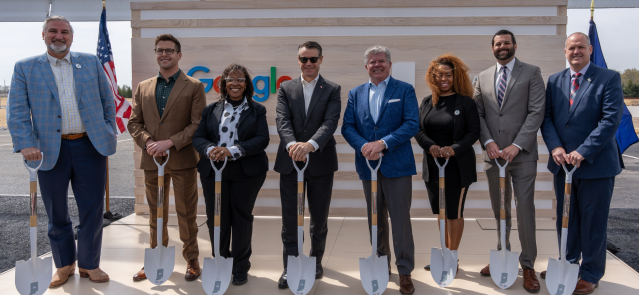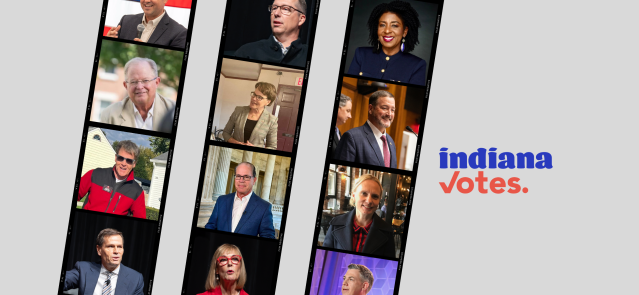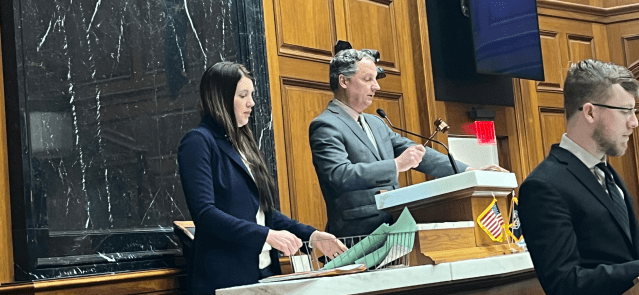Stay ahead of the curve as a political insider with deep policy analysis, daily briefings and policy-shaping tools.
Request a DemoIEDC head Brad Chambers talks about the LEAP district and a potential gubernatorial run
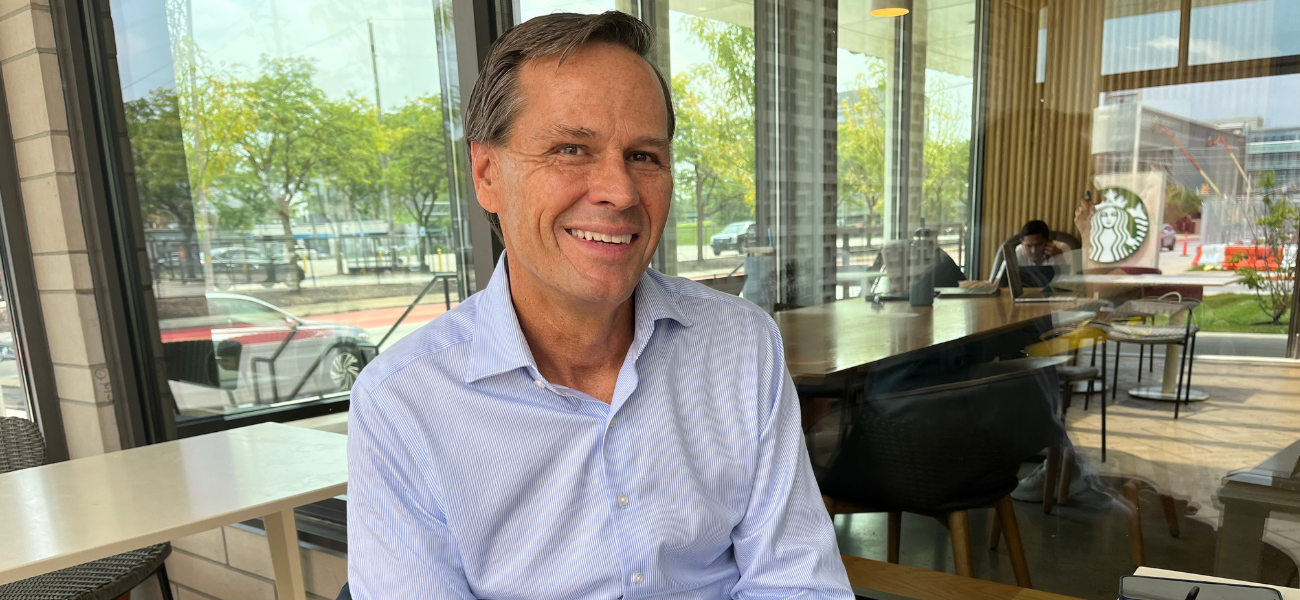
Secretary of Commerce Brad Chambers talks at a local Starbucks. (Credit: Kaitlin Lange)
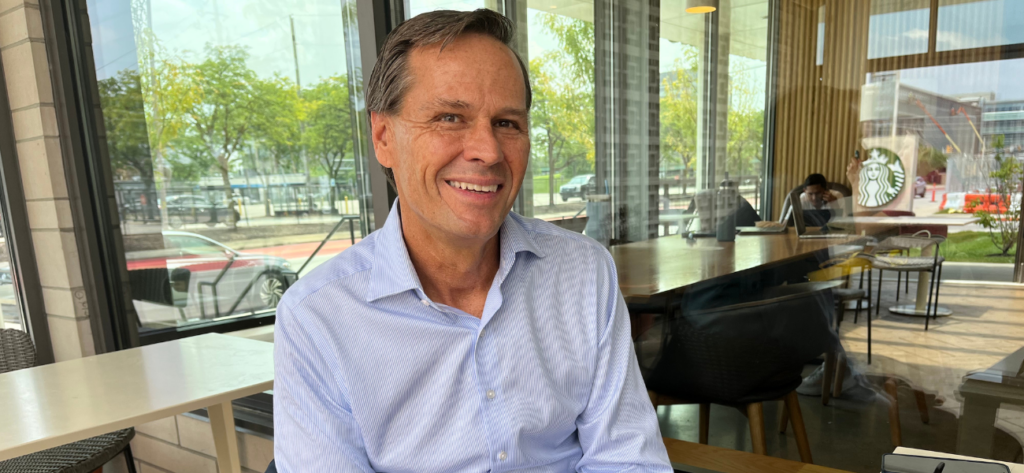
Secretary of Commerce Brad Chambers is still avoiding questions about his political future — at least for the next week or so.
The head of the Indiana Economic Development Corporation (IEDC) will be leaving his post Aug. 6 after two years on the job and confirmed to State Affairs that he is considering a gubernatorial run.
He’s just trying to “run through the tape” first.
“I don't know what I'm going to do, to be honest with you,” Chambers said. “I can foresee that in some way service will continue to be a theme in my life.”
Should he decide to run, Chambers would be at a sizable fundraising disadvantage against a field of four other serious Republican candidates, including another former IEDC head.
Gov. Eric Holcomb appointed Chambers, the founder and CEO of Indianapolis-based Buckingham Companies, to head the IEDC in 2021 after nearly four decades of experience in real estate development. During his time at the agency, the IEDC boasted record levels of economic investment.
But, what generated the most buzz during Chambers’ tenure was the IEDC’s establishment of the LEAP Lebanon Innovation District, a tech district in Boone County made possible by the agency buying up land. It signaled a dramatic change in how the IEDC functions and at times has been controversial, but economic leaders argue it enables the state to move more quickly when trying to attract companies.
State Affairs sat down with Chambers for a brief conversation about his accomplishments with the IEDC and what his thoughts are on a potential gubernatorial run.
This conversation has been edited for clarity, brevity and length.
Q. In what ways is the IEDC Improving life for all Hoosiers? In other words, why should the average Hoosier care what the IEDC does?
A. The commerce function of any state or country is really, really important. It generates interest in our economy, it generates jobs and wages. It focuses on investment and community, and focuses on workforce.
The same is true for the IEDC. A growing economy provides opportunity for our citizens. A growing economy provides higher wages, it provides quality of life for Hoosiers.
Q. So far in 2023, how many job commitments has the IEDC secured, and how many companies have committed to locate here or expand here?
A. We're really focused on two metrics, capital investment and wage levels. When you have an economy like ours that’s fully employed — like your unemployment rate is already low, it's less important to create new jobs because really, everybody's employed. So a focus area for us is the quality of that job and the quality of the business.
Through the last six quarters alone, we've generated $33 billion of investment. Last year, on an annualized basis, it was $22 [billion]. So far this year through July, [we generated] $11 billion. And if you double that $11 billion, because we're halfway through the year, that would be another $22 billion. So that would be $44 billion in my two years of capital investment in the state, which is historic and unprecedented.
The other thing that's really interesting and exciting about that is there's at least two new industries that have never been here before. [Electric vehicle] batteries. So leaning into the energy transition, leaning into Indiana’s long history and expertise and mobility. A big chunk of that $33 billion through the middle of this year is in that EV space.
And then semiconductors, which was not here before. There's six semiconductor transactions that have been booked in the last six quarters. Those new sectors, all that capital investment, drive higher wages which is what lift Hoosiers up. That was kind of my laser focus when I was intrigued about taking the offer from Governor Holcomb. I really feel that we had a great product, this place we call Indiana. We have a great workforce, great people. We have great universities. And so lifting people up to higher wages and better careers is really a focus area and we've been doing that.
Q. You're leaving the job here in a week. What do you think the IEDC’s biggest accomplishment has been since you took over as its leader?
A. It's hard to pick one, to be honest with you. I'm not going to give you one thing I'm proud of, but I will tell you, I'm proud of the team — the culture, their approach to the job. They’re quality focused, they’re enthusiastic, they’re mission focused and you can tell that through the accomplishments of the team.
If you look at the accomplishments, we've blown all capital investment records away, number one. Number two, the wage levels are higher than anytime in IEDC history. Last year, we got ranked as the number one place to start a business in the country by Forbes. And that's very consistent with our focus on entrepreneurship and small business. It's a very important part of our state's economy and in our country. Our state and our country were founded by entrepreneurs. Entrepreneurs are sticking, they hang around, they give back, they hire locally and they're just the biggest part of our economy.
I'm proud about how we're telling the Indiana story. I don't know if you've seen our winners ad, “Indiana for the winners.” I believe Indiana is for winners. We wouldn't put that ad out if it was just marketing. It’s not just marketing. We have a winning culture in our state, starting back in the early 1900s when Carl Fisher bought our track and turned it into the Indianapolis 500. It's a culture of winning and innovation, speed and accomplishment.
That ad alone has had 200 million global impressions. People really react at an emotional level to it. Being proud of our state, telling that story has dividends, and that dividend is $33 billion in the last six quarters with high-wage jobs.
Q. One of the more interesting things you've overseen during your time at the IEDC is the Lebanon Innovation District in Boone County. How did that signal a change in how the IEDC attempts to attract businesses?
A. As an entrepreneur and as a business owner for almost 40 years, one thing that's constant is change. The markets and how companies are evaluating their ability to grow their businesses has been rapidly changing in many respects since COVID. One of the first things I did was evaluate the competitive landscape, understand the marketplace by which Indiana is competing against Ohio, Arizona, how it’s competing against North Carolina and Texas and even China, and then evaluate what our competitors are doing against what we're doing, and then reconcile that.
Having a strategic site program was a reflection of the competition and global trends that are happening in the world. How do we make sure our economy is optimized, nimble to this current marketplace? How do we change, adapt to the marketplace, to our competitors, to maximize our ability to garner high-wage careers and industries to grow our economy into the future? That's how the LEAP strategy came about.
Our competitors are doing it successfully. The market demands it. These companies are making very large investments to gain market share very quickly, because industry is moving very quickly right now. Having a strategic site strategy was just really important for us to be competitive, and to win in the global economy.
The ink was not even dry on that concept of the LEAP Innovation District when we announced a $3.7 billion commitment to that park with Eli Lilly, Eli Lilly’s largest investment in company history. So I think the evidence is pretty good that we're on the right track. The location between Purdue and Indianapolis is a critically important location. It's going to power that region. It's going to boost up Lebanon, it's going to help Lafayette and Indianapolis. I think the future is bright for the region and the LEAP innovation strategy.
Q. You've mentioned the benefits of the IEDC being involved in real estate, but how have you addressed concerns that taxpayers are footing the bill for some of the risk associated with that?
A. You lose things in translation sometimes. To us it's absolutely an investment with a return to the taxpayer, a beneficial return. We calculate the dollars that go out of the IEDC to help invest in and support these new industries. We look at them as investments and we look at them with an actual financial return to the taxpayer. So, to us, this is not a cost. It's not an expense.
Q. One of the criticisms of the project has centered around getting enough water to the area. One Republican lawmaker during a legislative committee meeting said that it seemed like the IEDC had put the cart before the horse because of this issue. Did the IEDC consider how it would procure enough water before starting the project or is this something that popped up during the process? (Currently the plan is to draw water from Tippecanoe County).
A. Indiana is very fortunate. We have abundant water resources, we have abundant agricultural resources, we have abundant power. Sometimes that abundant resource of water is not in the right location. That condition existed before we identified that location for LEAP. We knew it, and we saw it actually as a benefit because we could solve a regional water problem at the same time that we could stimulate economic development growth like it's never been done.
So our view was not that it was a surprise, it was, “This is another reason to do it.” Because Boone County was going to run out of water in the next 15 years. It was going to start limiting its growth, and so being able to use economic development to solve a regional water problem was super strategic.
Now, I want to be really clear, we're not going to trade economic prosperity from another region for Boone County. That's not going to happen. We're being very deliberate about making sure the studies that we're doing by outside, third-party professionals are 110% accurate on the availability of water for everybody to flourish. We’re not going to shift the opportunity to flourish from one region to another just to do this project. The experts are telling us that's not the case. When they finally issue their report, the data will be out, but we believe there's plenty of water for Lafayette. It's an entirely different aquifer. We wouldn't do it if the experts didn't tell us that it's OK to do it, so that all boats are lifted, not just one or two.
Q. More than half of Indiana counties lost population between 2010 and 2020. Does the IEDC have a role in restoring the vibrancy to these communities?
A. It's a national trend. Population is changing just like other change that's happening. It's shifting around the country. It's shifting out of California and out of New York and Illinois. And it's shifting within the bounds and boundaries of Indiana. Indiana is growing its population, so let's start there with the good news of that. Fundamental to what I think our fighting strategy in a growing economy is a growing population.
So hats off to the governor and to the legislature for their investment in communities, their investment in growing our population through the [Regional Economic Acceleration and Development Initiative] program. There's very few if any states that are spending the kind of resources we are on a really innovative program that requires private match to state resources. We'll have somewhere between an 8 and $15 billion economic impact through the READI program statewide, and those are really quality of life-focused investments. Those are population growth investments, because to your point, population growth leads to workforce growth. Workforce growth leads to GDP growth.
We've been very focused on making sure the distribution of jobs that we recruit and investment is statewide versus just in a few areas. And there's really good news to share there. 50% or more of the capital investment that has been recruited to the state has been distributed throughout the state.
Q. Do you mean not just in central Indiana?
A. Yea, New Carlisle got a three-and-a-half billion-dollar EV plant. Terre Haute with ENTEK, a $1.5 billion investment. And there’s couple of announcements in Fort Wayne, in Marion, in Bedford. We're really focused on distribution, because jobs drive population growth too, and we want to make sure all of Indiana is thriving.
Q. I want to talk about you obviously.
A. I want to keep it focused on IEDC as much as we can.
Q. What’s next for you? Are you still considering a gubernatorial run?
A. Yeah, well thanks for asking. I've been obviously flattered. I'm going to run through the tape at IEDC. I'm going to finish strong and again, I'm just really proud of the accomplishments and achievements. I'm very thankful the governor asked me to step away from my business and to do this. I've been very rewarded by the results, by the team, by the contributions. It’s a service job. I did it for the service. And so service is kind of in my DNA, and it has been as part of our private company's DNA.
I don't know what I'm going to do, to be honest with you. I can foresee that in some way service will continue to be a theme in my life. And even so, I can't really talk about it because I'm still kind of doing this job, and when I get out of this job and give it a moment to give it a serious consideration, we'll see what the options are before me. But it's just been a good run, and I'm thankful for the opportunity.
Q. Do you have any idea of when you might make a decision as to whether or not you're running for governor?
A. I don’t.
Q. What factors are you weighing right now to make the decision?
A. I’m pushing everything off until after I get out of the IEDC role. I’m not giving it any thought until I get out of this role.
Q. Do you think you’re different enough from the other Republican candidates to add value to who is running for the race should you choose to run?
A. Well, I think that's obviously a voter question. The voter would have to decide if I'm different enough, but since I'm not a candidate, I don't need to spend a lot of time on it.
Q. I’m running out of time, so I'll go back to the bigger picture of economic development. When you talk to companies, what are they usually looking for in a state and what are some common reasons they might pass up Indiana?
A. Good question. First of all, I'm a lifelong Hoosier. I was educated in this state. I raised my family in this state. I grew a business and continue to grow the business in this state, so to say that I'm all in is an understatement. I'm all in on Indiana and after my two years as secretary of commerce, I am more of a believer in this product of Indiana. I'm all in on Hoosiers values, Midwestern values. I'm all in on our educational system. I think the higher educational system, we've got some things to work on, but who doesn’t. I'm all in on our economy and innovation that's happening. I'm all in on our workforce, all in our communities and quality of life.
The point is the product of Indiana is fantastic. We're very competitive. Sometimes [companies say no because] it's geographic. We're just not going to get them because they need to be in the south. “We need to be near a big customer or need to be near an ocean port.” We have great ports but we don't have ocean ports, so sometimes it's just that.
Sometimes you'll have states that aren't competitive like Indiana just dump money on them, and we're not going to do that. We don’t have to do that. Our best incentive is we have a great product and you can thrive economically in our state. We’re winning a lot as a state.
We had to revamp our toolkit. [For example,] the strategic site initiative. We’re funding a lot of things. We’re funding READI. We’re funding health care, you know, the governor’s 1500% increase in [funding for public] health care. We’re funding our public safety. We're funding economic development.
You're not going to find a state in the country that's perfect, but man, Indiana is working on its challenges. It's just taking advantage of its opportunities and I feel our state and our state's economy is very bright. I'm optimistic.
Contact Kaitlin Lange on Twitter @kaitlin_lange or at [email protected].
Twitter @stateaffairsins
Facebook @stateaffairsin
Instagram @stateaffairsin
LinkedIn @stateaffairs
Read this story for free.
Create AccountRead this story for free
By submitting your information, you agree to the Terms of Service and acknowledge our Privacy Policy.
Here’s how to vote in Indiana’s primary election
Thousands of Hoosier voters will head to the polls Tuesday, May 7, for Indiana’s primary election. This year’s ballot includes a competitive contest for governor, as well as dozens of state and federal legislative races and a few school referenda. The primary will decide which candidates will represent their respective parties in the Nov. 5 …
$15B in 72 hours: ‘Our economy is on fire,’ says Commerce chief
A banner week for investment within Indiana has capped off the state’s biggest financial quarter in recent history, as three major companies agreed to deals estimated to bring in billions of dollars.
The state has long advertised itself as business-friendly, and its chief executive appeared thrilled by the week’s news.
“This is about $15 billion in about 72 hours,” Gov. Eric Holcomb told reporters on Friday. “This used to take four years to achieve.”
One announced project, an $11 billion Amazon Web Services data center in north-central Indiana, is the biggest single investment in the state’s history.
Google also broke ground on a $2 billion data center near Fort Wayne, while Toyota announced a $1.4 billion investment in its Princeton plant.
“Our economy is on fire,” Secretary of Commerce David Rosenberg said.
His agency, the Indiana Economic Development Corp., negotiated the deals. The state is offering millions of dollars in tax incentives in order to create some 1,500 new jobs.
“These industries bring generational change for families, putting more money in their pockets and allowing them the opportunity to have a better quality of life on their own,” Rosenberg said.
The projects
Amazon’s new data center will be built near New Carlisle. It’s expected to bring in at least 1,000 new jobs in the artificial intelligence and cloud storage sectors. No timetable for completion of the project was given.
According to Amazon, the company has invested $21.5 billion in Indiana since 2010, creating 26,000 full- and part-time jobs.
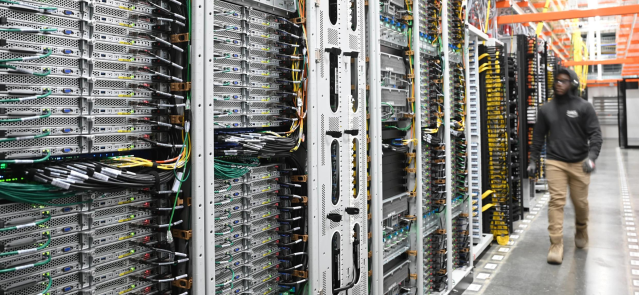
Google’s new data center will hire up to 200 new workers, the tech giant said, “in the coming years.”
Toyota will build a new assembly line that will assemble battery-operated SUVs by the end of 2025. It expects to add up to 340 new jobs to the plant, which Toyota said now employs more than 7,500.
The company has spent $8 billion on the Princeton plant since breaking ground in 1996, Toyota said.
The new projects’ figures represent early estimates and could change as they move forward.
Incentives aren’t the only factor
Rosenberg praised the Indiana General Assembly for passing legislation that allows the state to offer sales tax exemptions as a lure for new businesses. Both Amazon and Google will receive such boosts, and the Amazon project could receive up to $100 million in additional credits based on various incentives.
But Rosenberg stressed tax breaks are only part of the equation as the state looks to compete internationally.
“We don’t have to have the highest offer because we bring the university partners, the state and local governments, utilities — everyone around the table to make sure that company has what they need,” he said.
The Google project, for example, includes partnerships with Ivy Tech Community College on a new job training program and Indiana Michigan Power to bring clean energy resources to the local grid.
Recruiting new industries
Rosenberg said tech recruitment has been a particular focus for the IEDC, as Indiana is looking to provide an “ecosystem” for these companies to thrive off one another. The state’s semiconductor facilities will provide the materials needed for these new data centers, he noted.
Recruiting new business takes anywhere between six months to several years. Zoning, road construction, utilities and more need to be worked out ahead of time.
The IEDC has been on a hot streak, Rosenberg said. During the agency’s first 11 years, it secured just under $50 billion in new projects. It has now pulled in more than $71 billion since the beginning of 2022.
In the first four months of 2024, $20.68 billion has been pledged to projects in Indiana — the most for a quarter since IEDC’s founding in 2005.
‘Strong partners for the Indiana economy’
“The key is that these investments represent long-lasting and continued commitment to being strong partners for the Indiana economy,” said Andrew Butters, an associate professor of business economics and public policy at Indiana University’s Kelley School of Business.
Large companies came out of the pandemic looking to reorient their supply chains, Butters said, and some states have reaped the benefits of projects that might have previously moved overseas.
Indiana has been able to compete by selling its location, workforce, labor force participation in addition to offering incentives, Butters said.
“I would not be shocked to see more of these as the state attempts to transition toward more high-tech and high-skill industries,” Butters said.
Contact Rory Appleton on X at @roryehappleton or email him at [email protected].
6 races to watch in the Indiana primary election
The first openly competitive contest for the Republican gubernatorial nomination in a generation will end with Tuesday’s primary election, as will crowded races for several open congressional seats.
The primary won’t officially decide any political race — only the Nov. 5 general election can do that. But Republicans hold major advantages in statewide and many district-level contests, and who secures which nominations will go a long way toward deciding who may lead the state in the years to come.
>> Related: How does voting by political party work in Indiana?
Here are six key primary contests to watch on election night.
Governor
The race to be Indiana’s next chief executive has been perhaps the most noteworthy of the election cycle, with six Republicans bringing a variety of experience and outsider credentials to the competition.
Sen. Mike Braun has led in the polls from day one, including running up a 34 percentage-point lead in an April State Affairs/Howey Politics Indiana survey.
The other five candidates are: Lt. Gov. Suzanne Crouch, former Attorney General Curtis Hill, Indianapolis mom Jamie Reitenour and two former state secretaries of commerce in Brad Chambers and Eric Doden.
The winner of Tuesday’s Republican primary will face Democrat and former state Superintendent of Public Instruction Jennifer McCormick, who will advance for her party unopposed.
Republican candidates spent tens of millions of dollars in an attempt to stand out in their crowded pack. The primary race also featured four televised debates, including a chaotic final display on April 24.
U.S. Senate
Two Democrats are vying for the chance to replace Braun in the U.S. Senate: Former state Rep. Marc Carmichael and Valerie McCray, a clinical psychologist.
Carmichael has outspent McCray in the race by a margin of nearly $63,000 to $15,000.
Both are attempting to become the state’s first Democratic senator since Joe Donnelly’s election in 2012.
Rep. Jim Banks is running unopposed in the Republican primary.
3rd Congressional District
Banks’ entry into the Senate race leaves his seat in Congress open, and a bevy of Republicans are seeking to replace him: Grant Bucher, Wendy Davis, Mike Felker, Jon Kenworthy, Tim Smith, Marlin A. Stutzman, Eric Whalen and Andy Zay.
State Affairs has identified Stutzman, a former congressman; Smith, a self-funding former Fort Wayne mayoral candidate; and Davis, a former Allen County judge, as candidates to watch in the crowded race.
Kiley Adolph and Phil Goss are running against one another in the Democratic primary.
5th Congressional District
After initially deciding against another run, Republican Rep. Victoria Spartz reversed course to seek re-election in 2024.
Eight other Republicans are running against Spartz: Raju Chinthala, Max Engling, Chuck Goodrich, Mark Hurt, Patrick Malayter, Matthew Peiffer, L.D. Powell and Larry L. Savage Jr.
Goodrich, a member of the Indiana House of Representatives, has spent more than $2 million on TV ads as he seeks to unseat Spartz, according to AdImpact.
Two Democrats, Ryan Pfenninger and Deborah A. Pickett, are on the ballot.
6th Congressional District
Seven Republicans are attempting to replace retiring Rep. Greg Pence: Jamison E. Carrier, Darin Childress, Bill Frazier, John Jacob, state Sen. Jeff Raatz, Jefferson Shreve and state Rep. Mike Speedy.
Shreve, who ran unsuccessfully for Indianapolis mayor in 2023, has spent nearly $4 million — predominantly through TV advertising — in his bid.
Cynthia Wirth, whom Pence defeated by 35 percentage points in 2022, is running unopposed in the Democratic primary.
8th Congressional District
Republican Rep. Larry Bucshon is also retiring, and a dozen candidates in both parties are seeking to fill his seat.
On the Republican side, former Rep. John Hostettler, state Sen. Mark Messmer, former President Donald Trump White House staff member Dominick Kavanaugh and frequent Bucshon primary challenger Richard Moss are each making a push.
Fellow Republicans Jim Case, Jeremy Heath, Luke Misner and Kristi Risk are also running but trail the above pack in campaign spending.
Four Democrats are also seeking a nomination: Erik Hurt, Peter FH Priest II, Edward Upton Sein and Michael Talarzyk.
Contact Rory Appleton on X at @roryehappleton or email him at [email protected].
State Republicans keep spending to protect House incumbents in primary
House Speaker Todd Huston expressed confidence Tuesday that Republican House members will prevail over challengers in next week’s primary. Nineteen of the 63 House Republicans seeking reelection this year are facing primary races. Those challenges have been lower-key than two years ago when about two dozen candidates seized on COVID-19 discontent and other issues in …
